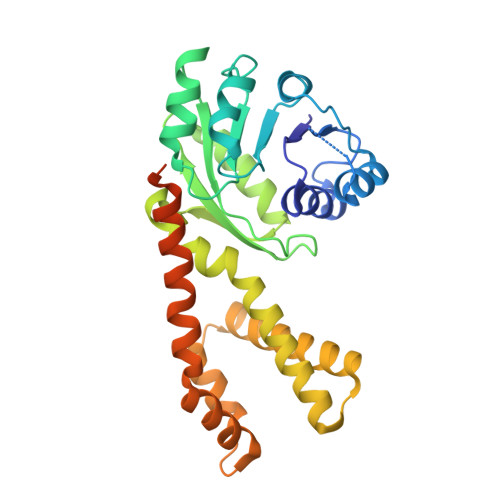Loss of PYCR2 Causes Neurodegeneration by Increasing Cerebral Glycine Levels via SHMT2.
Escande-Beillard, N., Loh, A., Saleem, S.N., Kanata, K., Hashimoto, Y., Altunoglu, U., Metoska, A., Grandjean, J., Ng, F.M., Pomp, O., Baburajendran, N., Wong, J., Hill, J., Beillard, E., Cozzone, P., Zaki, M., Kayserili, H., Hamada, H., Shiratori, H., Reversade, B.(2020) Neuron 107: 82-94.e6
- PubMed: 32330411
- DOI: https://doi.org/10.1016/j.neuron.2020.03.028
- Primary Citation of Related Structures:
6LHM - PubMed Abstract:
Patients lacking PYCR2, a mitochondrial enzyme that synthesizes proline, display postnatal degenerative microcephaly with hypomyelination. Here we report the crystal structure of the PYCR2 apo-enzyme and show that a novel germline p.Gly249Val mutation lies at the dimer interface and lowers its enzymatic activity. We find that knocking out Pycr2 in mice phenocopies the human disorder and depletes PYCR1 levels in neural lineages. In situ quantification of neurotransmitters in the brains of PYCR2 mutant mice and patients revealed a signature of encephalopathy driven by excessive cerebral glycine. Mechanistically, we demonstrate that loss of PYCR2 upregulates SHMT2, which is responsible for glycine synthesis. This hyperglycemia could be partially reversed by SHMT2 knockdown, which rescued the axonal beading and neurite lengths of cultured Pycr2 knockout neurons. Our findings identify the glycine metabolic pathway as a possible intervention point to alleviate the neurological symptoms of PYCR2-mutant patients.
- Institute of Medical Biology, Human Genetics and Embryology Laboratory, A(∗)STAR, Singapore 138648, Singapore; Genome Institute of Singapore, A∗STAR, Singapore 138672, Singapore; Department of Medical Genetics, Koç University, School of Medicine, 34010 Istanbul, Turkey. Electronic address: nathalie.escande@reversade.com.
Organizational Affiliation:
















